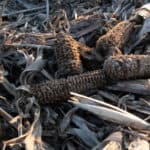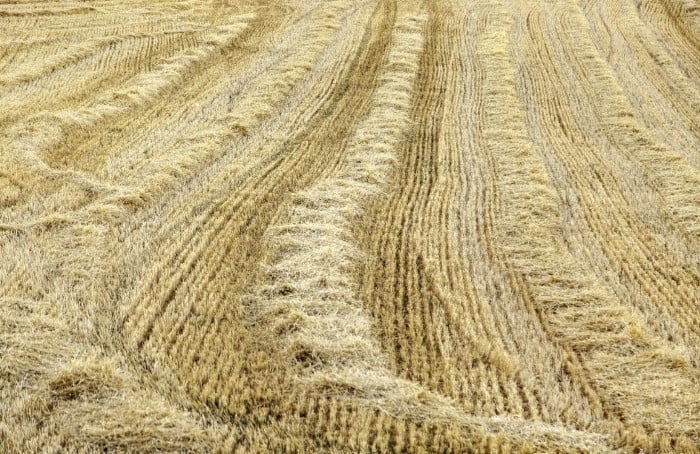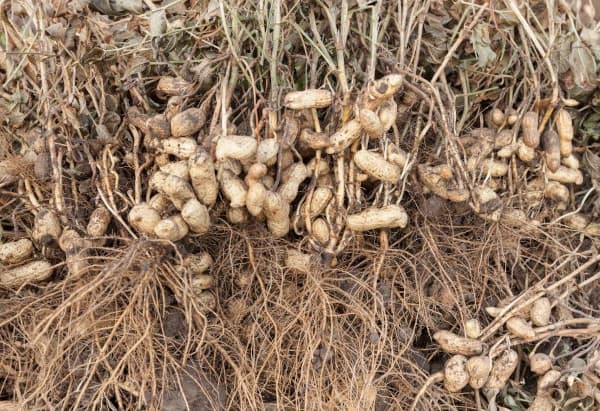In conversations with other deer hunters and land managers, one question or scenario that I’m routinely asked is this: If you only had one food plot available on a property, what would you plant?
This question is an easy one for me, and I don’t even have to give it much thought. My answer is a winter rye food plot. Winter rye is a cereal grain that is also commonly called cereal rye or winter cereal rye.
Throughout this post, I’ll use the terms winter rye and cereal rye interchangeably.
In this article, I’ll explore the benefits of winter rye for both soil and deer and why I consider it the best food plot option on the market.
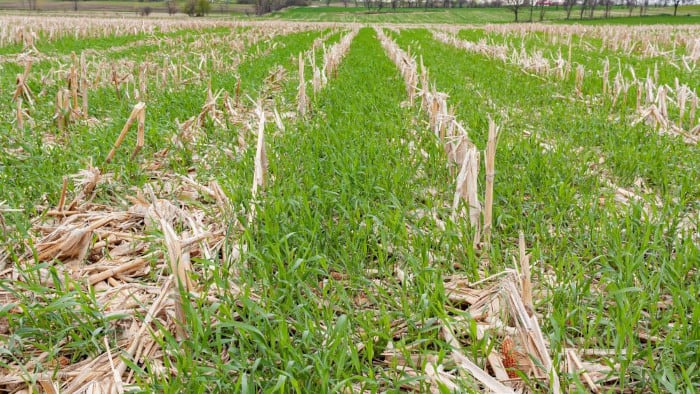
Important Takeaways
– Cereal rye is a great soil builder, increasing organic matter and nutrient release.
– It acts as a sponge, storing moisture in the soil and reducing erosion.
– Cereal rye provides stable 15% protein for deer, making it beneficial during harsh winters and for their feeding needs in late winter and early spring.
– It is a popular choice for food plots, easily grown and mixed with other crops for maximum soil building, weed control, and food production.
Why Winter Rye is My Top Food Plot Crop Option
As a food plot crop, winter rye has several characteristics that make it ideal for cold weather food plots:
Drought Resistant Seed
Cereal rye requires much less water than many other popular food plot crops, so it grows well in areas with little rainfall. Now, to be fair, the seed does require some water to germinate, but the roots do an outstanding job of retaining water for extended periods of time.
Can Grow in Poor Soil Conditions
Winter rye is one of the few crops that consistently grows well in poor soil conditions. Some examples of poor soil conditions include:
- Low Ph
- High Ph
- Sandy soil that doesn’t retain water
Provides a Deer Food Source Upon Germination
Unlike some food crops that are not a viable food source until the crop matures, winter rye is a viable food source as soon as it germinates. As a matter of fact, most of the winter rye plots I manage start experiencing grazing pressure when the plant shoots break the surface of the soil.
Grows Well With Other Plot Crops
While some food plot seeds seem to grow best by themselves, cereal rye grows exceptionally well when planted in conjunction with other popular food plot crops. I’ve planted cereal rye with the following crop seeds:
- Winter oats
- Clover
- Winter peas
- Winter wheat
- As a cover crop for corn
- Brassicas

Cereal Grain Rye Benefits for Soil
Winter cereal rye is an excellent choice for improving the soil because it increases organic matter, improves nutrient release, and acts as a sponge to store moisture.
When winter rye is grown in the soil, it contributes to the buildup of organic matter. This increased organic matter helps to improve soil structure and fertility, creating a more favorable environment for plant growth.
Additionally, cereal rye has the ability to release nutrients from its deep tap root, making them more available to other plants in the soil. This improved nutrient release can enhance the overall nutrient content of the soil, promoting healthier plant growth.
Furthermore, cereal rye acts as a sponge, absorbing and storing moisture in the soil. This sponge-like helps to prevent water runoff and erosion while also providing a steady water supply for plants.
Cereal Rye Benefits for Deer
Winter rye offers a solid 15% protein content, which serves as a vital source of nutrition for deer during the winter months when highly digestible protein is crucial. Not only does cereal rye offer a reliable food source, but its cold-friendly nature allows it to continue growing during intermittent winter thaws, providing a quick and accessible food option for deer.
This plant’s importance is further underscored by the fact that winter thaws and spring green-up can be challenging for deer, making cereal rye a lifeline during these critical times. Its ability to attract deer and provide essential nutrition makes cereal rye a top choice for hunters looking to support the survival and health of their deer population.
Winter Rye Planting and Management
When planting and managing cereal rye, I try to maximize its growth and benefits for deer. To achieve this, I try to use the following planting techniques and strategies:
Seed Rate and Timing
I prefer a heavy seed rate to ensure maximum soil building and weed control. My preferred seeding approach is to top seed, but I try to time the seeding just before a rain shower, as this facilitates germination and root establishment.
I also prefer to use Round-up resistant cereal seed as I typically use Round-up as weed treatment.
Top Seeding into Other Crops
To enhance food production and provide a diverse food source for deer, I prefer to top seed the winter rye into existing crops like corn, soybeans, and brassicas. This is done when the corn and beans start to turn colors or when the brassicas become mature.
In addition to offering some food diversity, I find that this approach also significantly increases the volume of available food from an existing crop.
Crop Management Practices
Once the cereal rye is established, I usually let it grow all summer. Then, in the fall, I’ll spray for weeds, then top seed it again with another round of cereal rye mix. This follow-up seeding approach not only fills in gaps as the initial planting is consumed by deer but also reduces the need for additional seed.
This approach may not work for everyone, but this planting technique has yielded excellent results for me and significantly increased the volume of food in my plots.
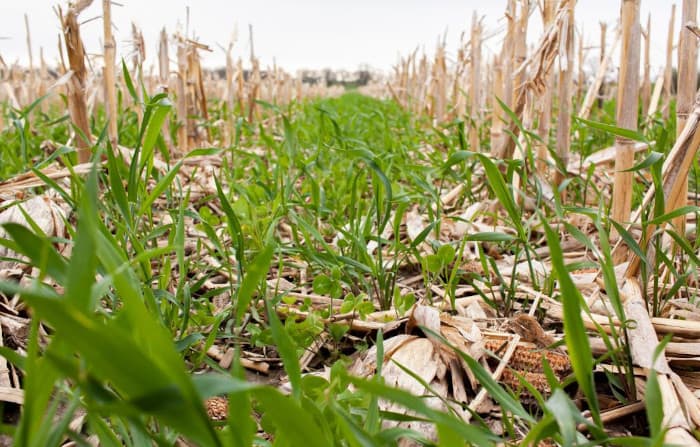
Frequently Asked Questions
Here are some commonly asked questions associated with cereal or winter rye food plots:
Can cereal rye be used as a cover crop in addition to being a food source for deer?
Cereal rye makes for an excellent cover crop in addition to being a food source for deer. It offers several benefits as a cover crop, including soil improvement, erosion control, and weed suppression. In addition, winter rye is almost always an excellent whitetail food source.
As a food source for deer, cereal rye provides stable protein levels and can be a reliable source of highly digestible protein during winter and early spring when deer need it the most.
How does cereal rye compare to other crops in terms of its ability to reduce erosion?
Cereal rye, in comparison to other crops, is a highly effective option for reducing soil erosion. Its deep tap root and ability to go dormant in freezing temperatures make it resilient against erosion-causing factors.
Furthermore, cereal rye offers significant environmental benefits in terms of erosion control. Its dense growth creates a physical barrier that prevents soil erosion. Additionally, the plant’s ability to absorb and store moisture in the soil further enhances its erosion-reducing capabilities.
Does cereal rye require any special care or maintenance during the winter months?
During the winter months, cereal rye requires little attention and maintenance to ensure its optimal growth and health. Because winter rye is a cold tolerant crop, it typically handles the winter months with very little maintenance.
Can winter rye be grown in areas with harsh freezing temperatures?
Yes, winter rye can be successfully grown in areas with harsh freezing temperatures. Despite the cold conditions, this species of rye has the ability to go dormant and quickly regrow when the soil thaws. This makes it an ideal cover crop for regions with freezing temperatures.
Are winter rye and winter ryegrass the same thing?
No, winter rye and winter ryegrass are two entirely different plant species. Winter rye is part of the cereal grain family, while winter ryegrass is part of the grass family. Whitetails do not like winter ryegrass, so I’d ensure I bought the right seed crop before planting.
If you mistakenly plant winter ryegrass seed instead of winter rye seed, it won’t take long to figure out as the deer will ignore it.
Why is Winter Rye considered a powerful soil builder?
Winter Rye is considered a powerful soil builder because it has an extensive root system that helps improve soil structure, prevents erosion, and increases organic matter content. Cereal or winter rye is a good option if you want to improve the soil in a food plot.
Does Winter Rye attract deer?
Winter rye is a favorite food source for white-tail deer because it’s easy to digest and has a high protein content. Deer are naturally drawn to the quality forage provided by winter rye, especially during the colder months when other food sources may be scarce.
When should I plant Winter Rye for a deer food plot?
Winter Rye (Cereal Rye) should be planted in the fall and even earlier in regions with cold winters. This allows the rye to establish itself before colder temperatures set in, ensuring it can provide green food for deer throughout the winter season.
How much Winter Rye should I plant per acre for a deer food plot?
The general recommendation is to plant around 50 to 75 pounds (or 1-3 bushels per acre) of Winter Rye per acre for a deer food plot. This planting density allows for optimal growth and provides enough forage for deer to utilize. As I mentioned before, I lean towards the higher seed density, so I usually seed around 75 pounds per acre.
Is Winter Rye a perennial or an annual plant?
Winter Rye is classified as an annual plant, meaning it completes its lifecycle within a year. It grows quickly, providing a green food source for deer within a few weeks of planting.
How deep should I plant Winter Rye seeds?
Winter Rye seeds should be planted at a depth of approximately 1/2 to 1 inch in well-prepared soil. This depth ensures good seed-to-soil contact, promoting quick germination and establishment.
Does Winter Rye require a soil test before planting?
I always recommend a soil test before planting any type of food plot. However, if there’s one crop that can survive without soil testing, it’s winter rye.
Is Winter Rye a good choice for poor soil conditions?
Winter Rye is an excellent choice for poor soil conditions. It is a hardy plant that can thrive even in soils with low fertility and suboptimal conditions.

